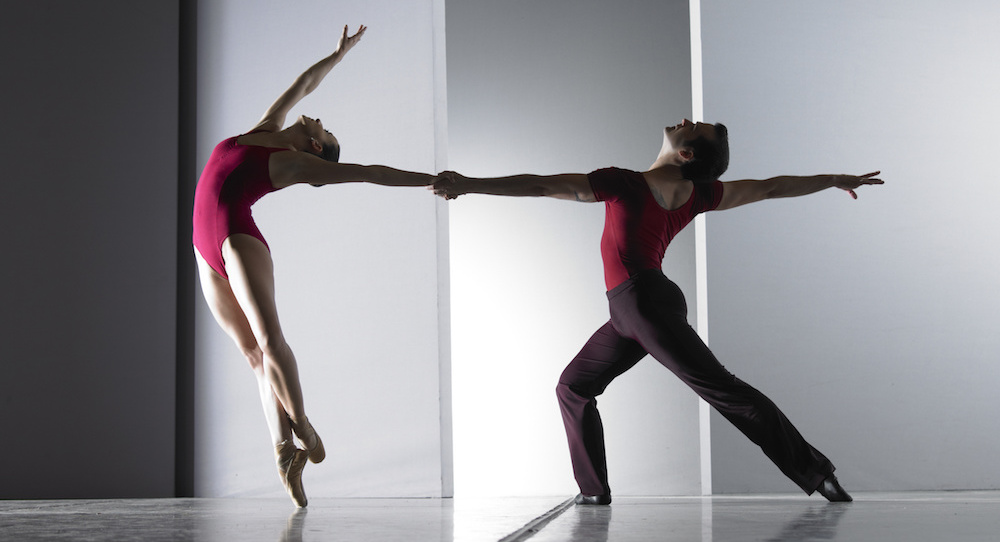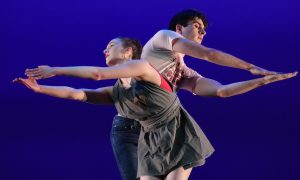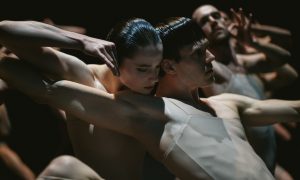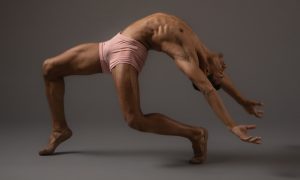The Sanctuary Theatre, Cambridge, Massachusetts.
May 6, 2017.
“I don’t wanna fall another moment into your gravity,” sings pop star Sara Bareilles in her hit song Gravity. She’s not referring to the invisible force that keeps our feet on the earth and our planet orbiting around the sun. She means an intangible force of attraction, one that is irresistible and indefatigable, to some other thing or person.
When dance art excels, it can have this pull on us. Our scattered modern minds can only focus on the beauty in front of us. We feel the dancers’ turns, reaches and falls in our very skin and bones. It truly has to be experienced live, in the very moments when dancers breathe and gaze, to be fully appreciated. Often also ephemeral, and irreplaceable, is how supportive visual and auditory elements of a performance merge with movement, to become more than the sum of their parts.
José Mateo Ballet Theatre’s Inescapable Orbit offered this type of multimedia cohesion that emerges as performance magic. And, although not without areas for growth, the work put forth true moments of that type of art to which one can’t help but be fully drawn – just as our moon is drawn to orbit around our planet.
Underscoring this effect of performance magic, in his program letter, José Mateo (company choreographer, artistic director and founder) said, “I hope the music and dance of…this program will propel you to an outer orbit from which escape will not matter.”
The first work, Risk of Repetition, explored and demonstrated possibilities within a structure of repeated phrases. Far from rote, the work also enticed with the unexpected – starting from an opening of a cluster of dancers taking tiny steps en pointe with their back to the audience. Not a trite opening in the slightest!
Use of cannon, with movement painted with slightly different brushes of nuance by each dancer, also helped the repetition avoid becoming old. Layers of the movement kept unpeeling. Fluid, yet strong, partnering contributed to these gradations coming through.
Pairs also worked together as truly collaborative teams. Repeated phrases between them echoed the habits we revert back to in relationships, romantic or otherwise, for good or ill. Soloist Joanna Binney executed crisp footwork and unexpected moments, such as a fearless release to the floor. Her partner, Spencer Doru Keith, offered extensions of infinitely expansive length – a never-ending geometric line.
Yet one might wonder what could have resulted from greater interaction amongst these pairs, perhaps more context around their relationships. Perhaps that is looking for meaning where it doesn’t need to be. In any case, costumes and lighting in a lavender collar scheme celebrated the spring season upon us. At the risk of repetition, we rejoice in the annual arrival of spring. The joyful energy of this piece could be part of that rejoicing.
This first piece certainly had its contemporary touches, yet the second, Still Waters, had more modern flair yet. A compelling phrase in this styling, for instance, was a battement à la seconde, followed by a brush of the back of the hand down the face and a close of the legs in parallel. Then elbows rose to create curved, wing-like arms. Music of choral voices layered on instrumentation (Claude Debussy’s “Nocturne III”) began to build a celestial, ethereal atmosphere.
Contributing to that atmosphere were moving pictures, in the dancers’ fluid bodies, such as a parallel passé with shifting wrists. Something in it embodied angels’ flight. Blue costumes and lighting aligned with that celestial feel. The title perhaps implied a joining of heaven and earth, the blue above and below. An overarching harmony matched both. The only element that didn’t seem to fully align with this atmosphere was a soloist (Angie DeWolf) in red.
Perhaps she represented the invasive forces of anger and strife that can seep into positive and peaceful atmospheres. Movement from her making that a bit clearer, one might argue, could be a valuable element to develop in future stagings of the work. Regardless, the prior piece was full of intriguing spacial tension, of building negative space. This one offered a folding together of formations, like mixing of baking ingredients to make batter. It was just as smooth and pleasing to experience.
The final work, Affairs, was a premiere. Like all of the five pieces, it invited – if not directly drew – the audience into its world. Like Still Waters, the choreography contained quasi-contemporary movement vocabulary, such as pencil turns and bent elbows (more so than in classical port de bras). The dancers demonstrated their versatility in performing this movement cleanly and cleverly.
DeWolf (also a soloist in this piece), for example, displayed a passionate push and pull of physical forces through her body, a commendable balance of technical mastery and a daring to take risks. Roger Creel, who replaced Colton West in the role, also offered a simultaneous technical command and intriguing individuality in his movement signature. It was difficult to look elsewhere as he turned, leapt and snaked through his spine. Magdalena Gyftopoulos was his frequent partner, a smooth and strong mover. Beyond them, dancers in formation were equally compelling.
A striking moment, for instance, was with three ballerinas – one in red sandwiched in a line by two in blue – walked backward in relevé. The way the light hit them was breathtaking. Another was with a section of dancers circling around the stage center. It seemed as if the center – with a mystery of its own, somehow – held the dancers in orbit by gravitational pull.
To end, a dancer stood alone on stage. We engage in the affairs of various relationships, but in the end, the only truly lasting and consistent one is that with our own consciousness. These moments were among those in true dance artistry that prove how most dance art needs to be experienced live to be truly and fully experienced. That ability to appreciate and savor aesthetic experience, that which we often can’t put into words, is a part of our very humanity.
“Something in us will always be drawn to orbit around the possibilities of creating and artmaking – to dream, to imagine to build, to innovate….dare one say we ever escape that orbit, then we will have lost part of our very essence,” Mateo stated in his program letter. I cannot say it more clearly and truthfully than that.
By Kathryn Boland of Dance Informa.















